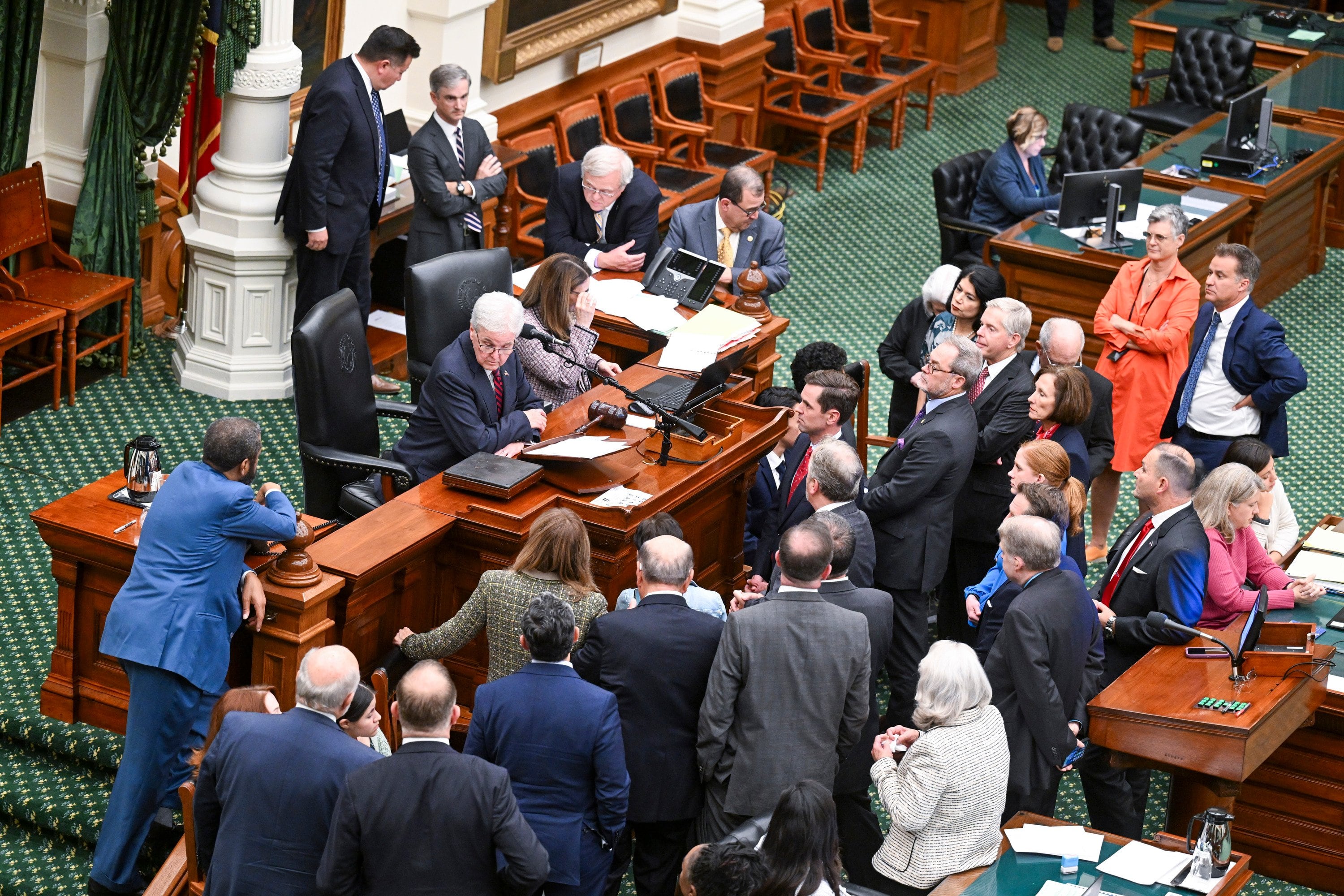Votebeat is a nonprofit news organization reporting on voting access and election administration across the U.S. Sign up for Votebeat Texas’ free newsletter here.
This story was first published by The Texas Tribune, a nonprofit, nonpartisan media organization that informs Texans — and engages with them — about public policy, politics, government and statewide issues.
The Texas Senate early Saturday morning approved a new congressional map gerrymandered to maximize Republican representation, sending the plan to the governor’s desk after weeks of intense partisan clashing.
Republican lawmakers pushed the plan through over fierce Democratic opposition, launching a national redistricting war from Albany to Sacramento while positioning the GOP to net up to five additional seats in Texas.
The Senate adopted the new lines on a party-line vote, 18 to 11, just after 12:30 a.m. Saturday following more than eight hours of at times tense debate.
Sen. Carol Alvarado, D-Houston, had planned to filibuster the map well into Saturday as a last stand against the effort, but a rare procedural motion by Senate Republicans just after midnight ended the debate and killed the filibuster, moving the chamber straight on to the final vote. Some observers in the gallery were removed for shouting “shame,” and “fascist,” shortly after the vote.
The map, demanded by President Donald Trump to fortify the GOP’s U.S. House majority in next year’s midterm election, hands up to five additional U.S. House seats to Republicans by dismantling Democratic bastions around Austin, Dallas and Houston, and by making two Democrat-held seats in South Texas redder. The new lines also keep all 25 seats already held by Republicans safely red.
The plan “meets the critically important goals of legality, of political performance for Republicans and of improved compactness,” said Sen. Phil King, R-Weatherford and House Bill 4’s sponsor, while repeatedly insisting under questioning from Democrats that he did not consider racial population data in his role shepherding the map through the upper chamber.
The pickups are meant to help the GOP hold onto its razor-thin congressional majority in a midterm election year that is expected to favor Democrats — potentially making the difference between a continued Republican trifecta in Washington, or a divided government with one chamber intent on investigating Trump and bottlenecking his agenda.
That has put Texas lawmakers at the front lines of an issue with national stakes. Republicans earned kudos from Trump for pushing the new boundaries through the state House, while Democrats won support from national party figures, including former President Barack Obama, Democratic National Committee Chair Ken Martin and U.S. House Minority Leader Hakeem Jeffries of New York.
In his closing statement, King made clear that the case for the map rested purely on maintaining Republican control of the federal government — and that if Texas did not push the gerrymander through, the GOP would likely lose control of the U.S. House in next year’s midterm election.
The “amazing progress that’s been made in just eight months — all of this will end if the Republicans lose the Congress,” King said after citing a list of policy achievements he attributed to a Republican trifecta. “I’m convinced that if Texas does not take this action, there is an extreme risk that that Republican majority will be lost. If it does, the next two years after the midterm, there will be nothing but inquisitions and impeachments and humiliation for our country.”
Republicans justify a partisan gerrymander as legal
Though congressional lines are typically redrawn once every 10 years following the decennial census, Republicans justified the aggressive and unusual move to do so in the middle of the decade by saying it was legal to craft new boundaries at any point and for purely partisan gain. They also pointed to the party’s margins of victory in 2024 and the need to counter blue-state gerrymandering to further support their push.
The U.S. Supreme Court ruled in 2019 that states can draw electoral maps on partisan grounds. But under Section 2 of the Voting Rights Act, the lines cannot diminish people’s voting power based on race.
Democrats argued that the new map increased Republicans’ advantage by unconstitutionally suppressing the vote of Black and Latino Texans. They framed the push as a power grab by Trump meant to stack the deck in next year’s election.
“Today, the majority will prevail, but the rights of minorities were ignored, outnumbered, outvoted and outgunned,” said Sen. Judith Zaffirini, D-Laredo and dean of the Senate. “Democrats will go down fighting, having used every available legislative tool. My prayer is that the pendulum will swing sooner rather than later, and that when it does, Democrats will respect all minorities, including political.”
Texas’ approval of the map has set off a tit-for-tat redistricting push in California, where Gov. Gavin Newsom has proposed a map voters would have to approve that could yield five new Democratic-leaning seats, effectively offsetting GOP gains in Texas. Other blue-state governors and national Democratic leaders are backing retaliatory gerrymandering as the Trump administration also pushes GOP-controlled Florida, Indiana, Missouri and Ohio to draw more red seats.
Democratic plan for filibuster falls through
Alvarado, with assistance from other Senate Democrats, had planned to filibuster the map Friday, donning sneakers and receiving a catheter in preparation. Sen. Sarah Eckhardt, D-Austin, had compiled over 12 hours of testimony from constituents on the map to read from during the marathon speech.
But after a three-hour dinner break called by Lt. Gov. Dan Patrick and objected to by Democrats, Republicans returned late Friday night with a procedural motion up their sleeves. Sen. Charles Perry, R-Lubbock, moved to cut off debate early. He cited a campaign email Alvarado sent out promoting the filibuster Friday afternoon, calling it “potentially unlawful,” and “at least unethical,” for ostensibly using state resources, such as staff and Capitol facilities, for fundraising purposes.
“It’s disrespectful. It violates the decorum of the Senate, and personally, I’m offended by it,” Perry said. All Republicans signed on to the motion.
Democrats condemned the explanation as an excuse to kill the filibuster and move the vote along, noting that senators routinely drew from their legislative work in their fundraising campaigns and that lawmakers were not under a fundraising moratorium as they are during the regular session.
“When they do it, it seems to be fair game, and when other people do it, then it’s a gotcha,” Alvarado said after the vote. “It was a mechanism to shut down the discussion, the debate on this issue.”
Republicans dragged Democrats back for special session
The filibuster would have delayed the map’s passage, but almost certainly would not have blocked it. Alvarado would have to had to sustain the filibuster for three weeks straight to run out the clock on the Legislature’s special session.
The new Texas map cleared its biggest hurdle Wednesday when, after more than eight hours of tense debate, the state House adopted the plan along party lines.
Lacking the votes to stop the map in the GOP-dominated Texas Legislature, more than 50 House Democrats staged a two-week walkout earlier this month, grinding the lower chamber to a halt by denying the quorum needed to conduct business.
Republicans unleashed an unprecedented response to drag them back to Texas, issuing civil arrest warrants, asking a court to extradite them from Illinois, seeking to declare over a dozen Democrats’ seats vacant and clamoring for legislative punishments upon their return.
After most Democratic lawmakers returned to Austin Monday, Republican Speaker Dustin Burrows, seeking to maintain a quorum, required each of them to agree to a police escort to leave the Capitol building. Rep. Nicole Collier, D-Fort Worth, refused and was confined to the Capitol for the next 54 hours, prompting a national media frenzy.
Democrats portrayed the walkout as a victory for sparking a national movement in support of retaliatory redistricting, and as just the first part of a longer fight against the map. In the House on Wednesday, Democratic lawmakers pressed their Republican colleagues on the plan’s impact on voters of color, working to establish a record they could use in a legal challenge seeking to kill the lines before next year’s election.
“This fight is far from over,” Rep. Gene Wu of Houston, chair of the House Democratic Caucus, said after the map’s passage in the lower chamber. “Our best shot is in the courts. This part of the fight is over, but it is merely the first chapter.”






